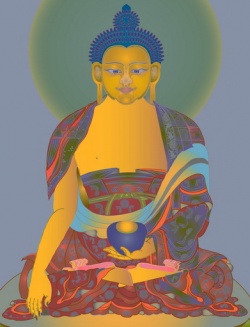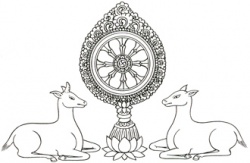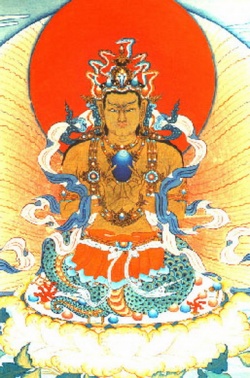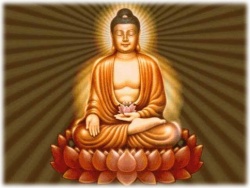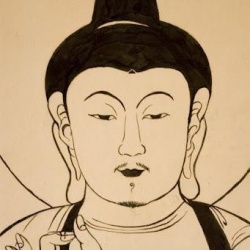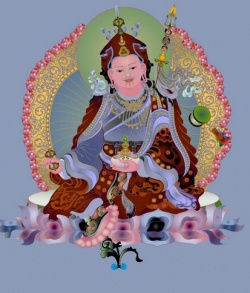Difference between revisions of "The Tree of Enlightenment: An Introduction to the Major Traditions of Buddhism - Chapter Twenty: The Development of Mahayana Philosophy"
m (Text replacement - "third stage" to "third stage") |
|||
| Line 4: | Line 4: | ||
[[Peter Della Santina]]}}<br/><br/> | [[Peter Della Santina]]}}<br/><br/> | ||
| − | ===Chapter Twenty <br/>The [[Development]] of [[Mahayana]] [[Philosophy]]=== | + | ===[[Chapter]] Twenty <br/>The [[Development]] of [[Mahayana]] [[Philosophy]]=== |
| − | In this chapter I would like to consider the further [[development]] of [[Mahayana]] [[philosophy]] in [[India]], the relationship between the [[Middle Way]] [[philosophy]] and the [[Mind Only]] [[philosophy]], and how these two influence the [[religious]] and practical [[traditions]] of [[Buddhism]]. We have discussed the [[Middle Way]] and [[Mind Only]] [[philosophies]] in Chapters 18 and 19, but have merely sketched the outlines of [[Mahayana]] [[philosophy]]. The [[philosophy]] of the [[Middle Way]], as presented by [[Nagarjuna]], and that of [[Mind Only]], as presented by [[Asanga]] and [[Vasubandhu]], are the twofold basis of the [[Mahayana tradition]], forming its general foundation as it evolved during the first four centuries of the common {{Wiki|era}}. | + | In this [[chapter]] I would like to consider the further [[development]] of [[Mahayana]] [[philosophy]] in [[India]], the relationship between the [[Middle Way]] [[philosophy]] and the [[Mind Only]] [[philosophy]], and how these two influence the [[religious]] and {{Wiki|practical}} [[traditions]] of [[Buddhism]]. We have discussed the [[Middle Way]] and [[Mind Only]] [[philosophies]] in Chapters 18 and 19, but have merely sketched the outlines of [[Mahayana]] [[philosophy]]. The [[philosophy]] of the [[Middle Way]], as presented by [[Nagarjuna]], and that of [[Mind Only]], as presented by [[Asanga]] and [[Vasubandhu]], are the twofold basis of the [[Mahayana tradition]], forming its general foundation as it evolved during the first four centuries of the common {{Wiki|era}}. |
This period was followed by another eight hundred years of [[philosophical]] [[development]] of the [[Mahayana tradition]] in [[India]], not to mention its continuing [[development]] in the other countries of {{Wiki|Asia}} to which [[Buddhism]] traveled--China, [[Korea]], [[Japan]], [[Tibet]], and [[Mongolia]]. To gain a comprehensive picture of this [[development]] in [[India]], I would like to trace the interaction between the [[Middle Way]] and [[Mind Only]] schools from the fourth century C.E. to the end of the first millennium. | This period was followed by another eight hundred years of [[philosophical]] [[development]] of the [[Mahayana tradition]] in [[India]], not to mention its continuing [[development]] in the other countries of {{Wiki|Asia}} to which [[Buddhism]] traveled--China, [[Korea]], [[Japan]], [[Tibet]], and [[Mongolia]]. To gain a comprehensive picture of this [[development]] in [[India]], I would like to trace the interaction between the [[Middle Way]] and [[Mind Only]] schools from the fourth century C.E. to the end of the first millennium. | ||
| − | Let us look first at what took place in the [[Middle Way]] school. The {{Wiki|principles}} set forth by [[Nagarjuna]] were elaborated by his [[disciples]] and successors, beginning with [[Aryadeva]]. Whereas [[Nagarjuna's]] primary [[concern]] had been to establish the authenticity of the [[philosophy]] of [[emptiness]] in opposition to the earlier schools of [[Buddhist philosophy]], [[Aryadeva's]] was to demonstrate that the [[philosophy]] of [[emptiness]] was equally valid in the case of the [[non-Buddhist]] [[Brahmanical]] and {{Wiki|Vedantic}} schools. | + | Let us look first at what took place in the [[Middle Way]] school. The {{Wiki|principles}} set forth by [[Nagarjuna]] were elaborated by his [[disciples]] and successors, beginning with [[Aryadeva]]. Whereas [[Nagarjuna's]] primary [[concern]] had been to establish the authenticity of the [[philosophy]] of [[emptiness]] in [[opposition]] to the earlier schools of [[Buddhist philosophy]], [[Aryadeva's]] was to demonstrate that the [[philosophy]] of [[emptiness]] was equally valid in the case of the [[non-Buddhist]] [[Brahmanical]] and {{Wiki|Vedantic}} schools. |
| − | The works of [[Nagarjuna]] and [[Aryadeva]] fall within the formative and fundamental period of the [[philosophy]] of the [[Middle Way]]. The period after [[Nagarjuna]] saw the [[emergence]] of two [[Middle Way]] sub-schools, the [[Prasangika]] and the [[Svatantrika]]. The division between these two schools is based on how they {{Wiki|present}} the [[philosophy]] of [[emptiness]]. | + | The works of [[Nagarjuna]] and [[Aryadeva]] fall within the formative and fundamental period of the [[philosophy]] of the [[Middle Way]]. The period after [[Nagarjuna]] saw the [[emergence]] of two [[Middle Way]] sub-schools, the [[Prasangika]] and the [[Svatantrika]]. The [[division]] between these two schools is based on how they {{Wiki|present}} the [[philosophy]] of [[emptiness]]. |
| − | When we discussed the [[philosophy]] of [[emptiness]] in Chapter 18, we spoke about a [[characteristic]] method of argument, the {{Wiki|reductio ad absurdum}}, that [[Middle Way]] [[philosophers]] used to reject the positions advanced by their opponents. In [[Sanskrit]] this [[form]] of argument is called [[prasanga]], and it was from this term that the [[Prasangika school]] took its [[name]]. Arguments ad absurdum are designed to expose contradictions and absurdities in opponents' positions. For example, the {{Wiki|theory}} of self-production (i.e., that entities originate from [[existent]] things) was advocated by a rival of the [[Prasangikas]], the [[Sankhya]] [[philosophical]] school. Self-production can be refuted by the argument that if entities originated from themselves, then they would go on originating indefinitely and we would have an [[endless]] series of reproductions of the same [[existing]] entities. In other words, there would be nothing new under the {{Wiki|sun}}. The [[prasanga]] argument is that entities do not originate from themselves because they already [[exist]], and the origination of something that already [[exists]] is plainly absurd. Besides, if [[existent]] entities do originate, then they will go on reproducing themselves ad infinitum. | + | When we discussed the [[philosophy]] of [[emptiness]] in [[Chapter]] 18, we spoke about a [[characteristic]] method of argument, the {{Wiki|reductio ad absurdum}}, that [[Middle Way]] [[philosophers]] used to reject the positions advanced by their opponents. In [[Sanskrit]] this [[form]] of argument is called [[prasanga]], and it was from this term that the [[Prasangika school]] took its [[name]]. Arguments ad absurdum are designed to expose contradictions and absurdities in opponents' positions. For example, the {{Wiki|theory}} of self-production (i.e., that entities originate from [[existent]] things) was advocated by a rival of the [[Prasangikas]], the [[Sankhya]] [[philosophical]] school. Self-production can be refuted by the argument that if entities originated from themselves, then they would go on originating indefinitely and we would have an [[endless]] series of reproductions of the same [[existing]] entities. In other words, there would be nothing new under the {{Wiki|sun}}. The [[prasanga]] argument is that entities do not originate from themselves because they already [[exist]], and the origination of something that already [[exists]] is plainly absurd. Besides, if [[existent]] entities do originate, then they will go on reproducing themselves ad infinitum. |
Alternatively, one might reject the [[Sankhya]] {{Wiki|theory}} of self-production by means of a [[syllogism]]. This [[form]] of argument is called an {{Wiki|independent}} ([[svatantra]]) argument, and it is from this term that the [[Svatantrika school]] got its [[name]]. One might illustrate this method of argument by saying, 'Entities do not originate from themselves.' This would be the proposition, the first so-called member of an {{Wiki|independent}} argument. Then one might say, 'This is because they [[exist]],' which would be the second member, the [[reason]] of the [[syllogism]]. Next, one might say, 'They [[exist]] like a jar does,' which would be the example, and the third and final member. By means of these three members of a [[syllogism]], one might demonstrate the impossibility of origination from self--the same [[objective]] demonstrated by an argument ad absurdum. | Alternatively, one might reject the [[Sankhya]] {{Wiki|theory}} of self-production by means of a [[syllogism]]. This [[form]] of argument is called an {{Wiki|independent}} ([[svatantra]]) argument, and it is from this term that the [[Svatantrika school]] got its [[name]]. One might illustrate this method of argument by saying, 'Entities do not originate from themselves.' This would be the proposition, the first so-called member of an {{Wiki|independent}} argument. Then one might say, 'This is because they [[exist]],' which would be the second member, the [[reason]] of the [[syllogism]]. Next, one might say, 'They [[exist]] like a jar does,' which would be the example, and the third and final member. By means of these three members of a [[syllogism]], one might demonstrate the impossibility of origination from self--the same [[objective]] demonstrated by an argument ad absurdum. | ||
| − | We have, therefore, two [[forms]] of argument, a reduction and a [[syllogism]] conforming to the rules of {{Wiki|formal logic}}. [[Buddhapalita]] and [[Chandrakirti]] are famous for their expositions championing the {{Wiki|reductio ad absurdum}}, while [[Bhavaviveka]] is famous for championing {{Wiki|syllogistic}}, {{Wiki|independent}} argument. Both the [[Prasangika]] and the [[Svatantrika school]] enjoyed considerable [[popularity]] in [[India]]. The strength of the [[Svatantrika school]] reflected an increasing [[concern]] with conforming to accepted standards of [[logic]]. It was common for rival [[Indian]] [[philosophical]] schools to engage in public [[debates]], which tended to require arguments that met accepted standards of validity. This led gradually to more formal requirements of [[discussion]] and influenced the [[philosophical]] arguments of the [[Middle Way]] school, contributing to the [[popularity]] of the [[Svatantrika]] sub-school, which favored the use of {{Wiki|independent}} argument. This trend even led the [[Prasangika]] sub-school to gradually refine and formalize its argument ad absurdum, so that within the course of a few hundred years, a much more formal presentation of the [[philosophy]] of [[emptiness]] emerged. | + | We have, therefore, two [[forms]] of argument, a reduction and a [[syllogism]] conforming to the {{Wiki|rules}} of {{Wiki|formal logic}}. [[Buddhapalita]] and [[Chandrakirti]] are famous for their [[expositions]] championing the {{Wiki|reductio ad absurdum}}, while [[Bhavaviveka]] is famous for championing {{Wiki|syllogistic}}, {{Wiki|independent}} argument. Both the [[Prasangika]] and the [[Svatantrika school]] enjoyed considerable [[popularity]] in [[India]]. The strength of the [[Svatantrika school]] reflected an increasing [[concern]] with conforming to accepted standards of [[logic]]. It was common for rival [[Indian]] [[philosophical]] schools to engage in public [[debates]], which tended to require arguments that met accepted standards of validity. This led gradually to more formal requirements of [[discussion]] and influenced the [[philosophical]] arguments of the [[Middle Way]] school, contributing to the [[popularity]] of the [[Svatantrika]] sub-school, which favored the use of {{Wiki|independent}} argument. This trend even led the [[Prasangika]] sub-school to gradually refine and formalize its argument ad absurdum, so that within the course of a few hundred years, a much more formal presentation of the [[philosophy]] of [[emptiness]] emerged. |
Just as this was taking place within the [[Middle Way]] school, developments were also occurring within the [[Mind Only school]]. The next significant [[Mind Only]] [[philosophers]] in [[India]] were the fifth century [[Buddhist logicians]] [[Dinnaga]] and [[Dharmakirti]], who also played a significant role in the [[development]] of the [[Mind Only]] [[philosophy]]. They rejected the [[existence]] of the [[objects]] of consciousness--of [[forms]], {{Wiki|sounds}}, and so forth--present in [[experience]], and are therefore known as the [[philosophers]] who reject the {{Wiki|representations}} of [[consciousness]]. Whereas both [[Asanga]] and [[Vasubandhu]] [[affirmed]] the [[existence]] of the [[objects]] of [[consciousness]], insofar as these participate in the [[reality]] of [[mind]], [[Dinnaga]] and [[Dharmakirti]] maintained that, although the [[reality]] of [[consciousness]] is indubitable, the [[reality]] of the [[forms]], or [[objects]], of [[consciousness]] is not. | Just as this was taking place within the [[Middle Way]] school, developments were also occurring within the [[Mind Only school]]. The next significant [[Mind Only]] [[philosophers]] in [[India]] were the fifth century [[Buddhist logicians]] [[Dinnaga]] and [[Dharmakirti]], who also played a significant role in the [[development]] of the [[Mind Only]] [[philosophy]]. They rejected the [[existence]] of the [[objects]] of consciousness--of [[forms]], {{Wiki|sounds}}, and so forth--present in [[experience]], and are therefore known as the [[philosophers]] who reject the {{Wiki|representations}} of [[consciousness]]. Whereas both [[Asanga]] and [[Vasubandhu]] [[affirmed]] the [[existence]] of the [[objects]] of [[consciousness]], insofar as these participate in the [[reality]] of [[mind]], [[Dinnaga]] and [[Dharmakirti]] maintained that, although the [[reality]] of [[consciousness]] is indubitable, the [[reality]] of the [[forms]], or [[objects]], of [[consciousness]] is not. | ||
| − | In about the eighth century C.E., there arose in [[India]] a figure of note, a [[scholar]] who made a very important contribution to the {{Wiki|integration}} of these different {{Wiki|tendencies}} within [[Mahayana]] [[philosophy]]. His [[name]] was [[Shantarakshita]]. In addition to the [[fame]] he won as a result of his [[philosophical]] and {{Wiki|literary}} production, [[Shantarakshita]] was the first to introduce systematic [[Buddhist]] [[thought]] to [[Tibet]]. He formulated what we now call the {{Wiki|syncretic}} or synthetic [[philosophy]] that unites in a systematic way the [[philosophy]] of [[emptiness]] and the [[philosophy]] of [[Mind Only]]. | + | In about the eighth century C.E., there arose in [[India]] a figure of note, a [[scholar]] who made a very important contribution to the {{Wiki|integration}} of these different {{Wiki|tendencies}} within [[Mahayana]] [[philosophy]]. His [[name]] was [[Shantarakshita]]. In addition to the [[fame]] he won as a result of his [[philosophical]] and {{Wiki|literary}} production, [[Shantarakshita]] was the first to introduce systematic [[Buddhist]] [[thought]] to [[Tibet]]. He formulated what we now call the {{Wiki|syncretic}} or {{Wiki|synthetic}} [[philosophy]] that unites in a systematic way the [[philosophy]] of [[emptiness]] and the [[philosophy]] of [[Mind Only]]. |
| − | We have discussed the importance of [[mind]] in the [[thought]] of the [[Middle Way]] school, and also the parallelism between [[conventional truth]] and [[ultimate truth]] on the one hand and the [[illusory]] and perfected natures on the other. We indicated the parallel {{Wiki|status}} of [[mind]], [[interdependence]], and the dependent [[nature]] in the [[Middle Way]] and [[Mind Only]] schools (see Chapter 19). What we have in the [[thought]] of [[Shantarakshita]] is a systematic {{Wiki|integration}} of the major {{Wiki|tenets}} of the [[Middle Way]] and the [[Mind Only]] schools, so that [[emptiness]] is [[acknowledged]] to be consistent with [[ultimate truth]] and the perfected [[nature]], while the creative [[nature]] of [[consciousness]] is [[acknowledged]] to be consistent with the [[conventional truth]] and the [[illusory]] [[nature]]. | + | We have discussed the importance of [[mind]] in the [[thought]] of the [[Middle Way]] school, and also the parallelism between [[conventional truth]] and [[ultimate truth]] on the one hand and the [[illusory]] and perfected natures on the other. We indicated the parallel {{Wiki|status}} of [[mind]], [[interdependence]], and the dependent [[nature]] in the [[Middle Way]] and [[Mind Only]] schools (see [[Chapter]] 19). What we have in the [[thought]] of [[Shantarakshita]] is a systematic {{Wiki|integration}} of the major {{Wiki|tenets}} of the [[Middle Way]] and the [[Mind Only]] schools, so that [[emptiness]] is [[acknowledged]] to be consistent with [[ultimate truth]] and the perfected [[nature]], while the creative [[nature]] of [[consciousness]] is [[acknowledged]] to be consistent with the [[conventional truth]] and the [[illusory]] [[nature]]. |
In addition to the reconciliation and stratification of the [[principle]] {{Wiki|tenets}} of these two schools, [[Shantarakshita's]] [[philosophy]] integrates the [[elements]] of [[logical]] argument and treats systematically the role of [[mind]] in the origination and [[cessation of suffering]]. In his {{Wiki|syncretic}} [[philosophy]] we have what we might term the apex of the [[development]] of [[Mahayana]] [[philosophy]] in [[India]], in that [[Shantarakshita]] correlated and synthesized, in one coherent [[philosophical]] system, the [[principal]] [[insights]] of outstanding [[Mahayana]] [[masters]] like [[Nagarjuna]], [[Asanga]], and [[Vasubandhu]]. | In addition to the reconciliation and stratification of the [[principle]] {{Wiki|tenets}} of these two schools, [[Shantarakshita's]] [[philosophy]] integrates the [[elements]] of [[logical]] argument and treats systematically the role of [[mind]] in the origination and [[cessation of suffering]]. In his {{Wiki|syncretic}} [[philosophy]] we have what we might term the apex of the [[development]] of [[Mahayana]] [[philosophy]] in [[India]], in that [[Shantarakshita]] correlated and synthesized, in one coherent [[philosophical]] system, the [[principal]] [[insights]] of outstanding [[Mahayana]] [[masters]] like [[Nagarjuna]], [[Asanga]], and [[Vasubandhu]]. | ||
| − | The synthesis of the {{Wiki|tenets}} of [[emptiness]] and [[Mind Only]] had a direct and determining impact on the two major [[traditions]] that grew out of [[Mahayana]] [[philosophy]]: (1) the [[Vajrayana]], which held sway in [[Tibet]] and [[Mongolia]], and (2) the [[Ch'an]] [[Zen]] [[tradition]], which was predominant in [[China]] and [[Japan]]. Although these two [[traditions]] of practice differ markedly in the [[forms]] of their [[religious]] expression, both rely very heavily on the {{Wiki|tenets}} of [[emptiness]] and [[Mind Only]] for their [[function]] and effectiveness. | + | The {{Wiki|synthesis}} of the {{Wiki|tenets}} of [[emptiness]] and [[Mind Only]] had a direct and determining impact on the two major [[traditions]] that grew out of [[Mahayana]] [[philosophy]]: (1) the [[Vajrayana]], which held sway in [[Tibet]] and [[Mongolia]], and (2) the [[Ch'an]] [[Zen]] [[tradition]], which was predominant in [[China]] and [[Japan]]. Although these two [[traditions]] of practice differ markedly in the [[forms]] of their [[religious]] expression, both rely very heavily on the {{Wiki|tenets}} of [[emptiness]] and [[Mind Only]] for their [[function]] and effectiveness. |
In the [[Vajrayana]], it is the [[philosophy]] of [[emptiness]] which supplies the [[openness]] and {{Wiki|fluidity}} that allows for the [[transformation]] of [[phenomena]] from an impure [[condition]] to a [[pure]] [[condition]]. If entities had an {{Wiki|independent}} and [[unchanging]] [[nature]] and were therefore not [[empty]], it would be impossible to [[transform]] impure [[experience]] saturated by [[suffering]] into [[pure]] [[experience]] suffused by great [[bliss]]. While [[emptiness]] supplies the ground upon which this [[transformation]] can take place, [[mind]] supplies the effective means of achieving that [[transformation]], because it is the [[mind]] that shapes and determines the [[nature]] of our [[experience]]. By controlling, disciplining, and manipulating the [[mind]], we can change our [[experience]] from an impure [[experience]] to a [[pure]] [[experience]]. In the {{Wiki|theory}} and practice of the [[Vajrayana tradition]], [[emptiness]] and [[mind]] are indispensable--both because, without [[emptiness]], [[transformation]] of things would be impossible, and because it is [[mind]] that is the key to and means of achieving that [[transformation]]. | In the [[Vajrayana]], it is the [[philosophy]] of [[emptiness]] which supplies the [[openness]] and {{Wiki|fluidity}} that allows for the [[transformation]] of [[phenomena]] from an impure [[condition]] to a [[pure]] [[condition]]. If entities had an {{Wiki|independent}} and [[unchanging]] [[nature]] and were therefore not [[empty]], it would be impossible to [[transform]] impure [[experience]] saturated by [[suffering]] into [[pure]] [[experience]] suffused by great [[bliss]]. While [[emptiness]] supplies the ground upon which this [[transformation]] can take place, [[mind]] supplies the effective means of achieving that [[transformation]], because it is the [[mind]] that shapes and determines the [[nature]] of our [[experience]]. By controlling, disciplining, and manipulating the [[mind]], we can change our [[experience]] from an impure [[experience]] to a [[pure]] [[experience]]. In the {{Wiki|theory}} and practice of the [[Vajrayana tradition]], [[emptiness]] and [[mind]] are indispensable--both because, without [[emptiness]], [[transformation]] of things would be impossible, and because it is [[mind]] that is the key to and means of achieving that [[transformation]]. | ||
| Line 36: | Line 36: | ||
Thus it is not coincidental that both the [[Vajrayana]] and the [[Ch'an]] and [[Zen]] [[traditions]] look to these fundamental [[ideas]] of the [[Indian]] [[Mahayana]] for their inspiration. [[Nagarjuna]] and [[Asanga]] are [[traditionally]] regarded as the founders of the [[Vajrayana tradition]]; [[Nagarjuna]] is also one of the early [[patriarchs]] of the [[Ch'an]] and [[Zen]] [[tradition]]. [[Bodhidharma]], who introduced [[Ch'an]] to [[China]], is said to have favored the [[Lankavatara]] [[Sutra]] above all other texts. In this way, the [[Middle Way]] and [[Mind Only]] schools played an important role in the [[development]] of the [[principal]] [[traditions]] of [[Mahayana]] practice throughout {{Wiki|Asia}}. | Thus it is not coincidental that both the [[Vajrayana]] and the [[Ch'an]] and [[Zen]] [[traditions]] look to these fundamental [[ideas]] of the [[Indian]] [[Mahayana]] for their inspiration. [[Nagarjuna]] and [[Asanga]] are [[traditionally]] regarded as the founders of the [[Vajrayana tradition]]; [[Nagarjuna]] is also one of the early [[patriarchs]] of the [[Ch'an]] and [[Zen]] [[tradition]]. [[Bodhidharma]], who introduced [[Ch'an]] to [[China]], is said to have favored the [[Lankavatara]] [[Sutra]] above all other texts. In this way, the [[Middle Way]] and [[Mind Only]] schools played an important role in the [[development]] of the [[principal]] [[traditions]] of [[Mahayana]] practice throughout {{Wiki|Asia}}. | ||
| − | Let us spend some [[time]] looking at the method of [[investigation]] that was developed in [[India]] in line with the [[insights]] of the [[Middle Way]] and [[Mind Only]] schools. The fundamental division of [[experience]] into [[subject]] ([[nama]]) and [[object]] ([[rupa]]), found in the scheme of the [[five aggregates]] and in many of the analytical schemes of the [[Abhidharma]], is also {{Wiki|present}} in the [[Mahayana]] context. We can see the [[investigation]] of [[reality]] unfolding in this binary way with [[respect]] first to the [[object]] and then to the [[subject]]. | + | Let us spend some [[time]] looking at the method of [[investigation]] that was developed in [[India]] in line with the [[insights]] of the [[Middle Way]] and [[Mind Only]] schools. The fundamental [[division]] of [[experience]] into [[subject]] ([[nama]]) and [[object]] ([[rupa]]), found in the scheme of the [[five aggregates]] and in many of the analytical schemes of the [[Abhidharma]], is also {{Wiki|present}} in the [[Mahayana]] context. We can see the [[investigation]] of [[reality]] unfolding in this binary way with [[respect]] first to the [[object]] and then to the [[subject]]. |
| − | In investigating the [[object]] and the [[subject]], two methods are used that we have encountered in other [[Buddhist traditions]] also--namely, the analytical method and the relational method (see Chapter 16). Beginning with the [[object]], we find first an analytical [[investigation of the object]] applied. This means, in the [[Mahayana]] context, a [[consideration]] of the [[infinite]] divisibility of the [[object]]. We have discussed the importance of the [[infinite]] divisibility of {{Wiki|matter}} in the formulation of [[Mind Only]] [[philosophy]] (see Chapter 19). Here, too, we begin with the [[investigation]] and [[revelation]] of matter's [[infinite]] divisibility. | + | In investigating the [[object]] and the [[subject]], two methods are used that we have encountered in other [[Buddhist traditions]] also--namely, the analytical method and the relational method (see [[Chapter]] 16). Beginning with the [[object]], we find first an analytical [[investigation of the object]] applied. This means, in the [[Mahayana]] context, a [[consideration]] of the [[infinite]] divisibility of the [[object]]. We have discussed the importance of the [[infinite]] divisibility of {{Wiki|matter}} in the formulation of [[Mind Only]] [[philosophy]] (see [[Chapter]] 19). Here, too, we begin with the [[investigation]] and [[revelation]] of matter's [[infinite]] divisibility. |
This analytical [[investigation of the object]] is followed by a relational [[investigation of the object]], which reveals that the [[object]] depends on the subject--that is, on [[consciousness]]. In this way, we arrive at the rejection of the notion of an {{Wiki|independent}} [[object]] both analytically and relationally. | This analytical [[investigation of the object]] is followed by a relational [[investigation of the object]], which reveals that the [[object]] depends on the subject--that is, on [[consciousness]]. In this way, we arrive at the rejection of the notion of an {{Wiki|independent}} [[object]] both analytically and relationally. | ||
| Line 50: | Line 50: | ||
You may recall our use of the [[word]] '[[pure]]' as a {{Wiki|synonym}} of [[empty]]. Here we have another [[word]] used, '[[luminous]].' You need not be confused by this. It is simply a restatement of that equivalence set forth in the [[Heart]] [[Sutra's]] [[assertion]] that '[[Emptiness]] is [[form]], and [[form]] is [[emptiness]].' [[Reality]] is not only [[empty]]: it is also [[form]]; it is also [[luminous]], bright with the potential for [[appearance]]. This luminosity--this potential [[inherent]] in the real state of things--manifests itself to the impure, [[afflicted consciousness]] as [[samsara]], but it [[manifests]] itself to the [[purified]] [[consciousness]] as the [[pure]] [[universe]] of the [[exalted]] [[Buddhas]] and [[Bodhisattvas]]. It is within the context of this [[luminosity]], this potential [[appearance]] of [[reality]], that we have the [[manifestation]] of the [[celestial]] [[Buddhas]] and [[Bodhisattvas]] like [[Amitabha]], [[Akshobhya]], [[Avalokiteshvara]], [[Manjushri]], and the rest. They are [[luminous]], [[pure]], and the bright [[manifestation]] of reality--that [[reality]] which is simultaneously [[emptiness]] and [[luminosity]], [[emptiness]] and [[purity]]. [[Emptiness]] and [[luminosity]] are the [[characteristics]] of [[reality]] that emerge from the [[Mahayanic]] [[investigation]] of the [[subject]] and [[object]] of [[experience]]. | You may recall our use of the [[word]] '[[pure]]' as a {{Wiki|synonym}} of [[empty]]. Here we have another [[word]] used, '[[luminous]].' You need not be confused by this. It is simply a restatement of that equivalence set forth in the [[Heart]] [[Sutra's]] [[assertion]] that '[[Emptiness]] is [[form]], and [[form]] is [[emptiness]].' [[Reality]] is not only [[empty]]: it is also [[form]]; it is also [[luminous]], bright with the potential for [[appearance]]. This luminosity--this potential [[inherent]] in the real state of things--manifests itself to the impure, [[afflicted consciousness]] as [[samsara]], but it [[manifests]] itself to the [[purified]] [[consciousness]] as the [[pure]] [[universe]] of the [[exalted]] [[Buddhas]] and [[Bodhisattvas]]. It is within the context of this [[luminosity]], this potential [[appearance]] of [[reality]], that we have the [[manifestation]] of the [[celestial]] [[Buddhas]] and [[Bodhisattvas]] like [[Amitabha]], [[Akshobhya]], [[Avalokiteshvara]], [[Manjushri]], and the rest. They are [[luminous]], [[pure]], and the bright [[manifestation]] of reality--that [[reality]] which is simultaneously [[emptiness]] and [[luminosity]], [[emptiness]] and [[purity]]. [[Emptiness]] and [[luminosity]] are the [[characteristics]] of [[reality]] that emerge from the [[Mahayanic]] [[investigation]] of the [[subject]] and [[object]] of [[experience]]. | ||
| − | Let me conclude by describing a practical mode of contemplation which reflects this progressive [[insight]] that eventually reveals the {{Wiki|ineffable}} [[character]] of the real. This {{Wiki|contemplative}} technique of [[meditation]] unfolds through four stages. | + | Let me conclude by describing a {{Wiki|practical}} mode of contemplation which reflects this progressive [[insight]] that eventually reveals the {{Wiki|ineffable}} [[character]] of the real. This {{Wiki|contemplative}} technique of [[meditation]] unfolds through four stages. |
The [[first stage]] involves contemplation of the mind-dependent [[nature]] of all [[experience]]. On this stage we are asked to regard all [[experience]] as similar to a [[dream]]. This is reinforced by recourse to examples that illustrate the mind-dependent [[nature]] of [[experience]]: not only the [[experience]] of [[dreaming]], which is perhaps the most telling but also that of {{Wiki|illness}}, when one [[perceives]] a white [[conch]] as yellow because of jaundice, and the [[experience]] of altered [[perception]] as a result of the ingestion of {{Wiki|hallucinogenic}} {{Wiki|substances}}. | The [[first stage]] involves contemplation of the mind-dependent [[nature]] of all [[experience]]. On this stage we are asked to regard all [[experience]] as similar to a [[dream]]. This is reinforced by recourse to examples that illustrate the mind-dependent [[nature]] of [[experience]]: not only the [[experience]] of [[dreaming]], which is perhaps the most telling but also that of {{Wiki|illness}}, when one [[perceives]] a white [[conch]] as yellow because of jaundice, and the [[experience]] of altered [[perception]] as a result of the ingestion of {{Wiki|hallucinogenic}} {{Wiki|substances}}. | ||
Revision as of 17:53, 3 January 2015
The Tree of Enlightenment
An Introduction to the Major Traditions of Buddhism
Peter Della Santina
Chapter Twenty
The Development of Mahayana Philosophy
In this chapter I would like to consider the further development of Mahayana philosophy in India, the relationship between the Middle Way philosophy and the Mind Only philosophy, and how these two influence the religious and practical traditions of Buddhism. We have discussed the Middle Way and Mind Only philosophies in Chapters 18 and 19, but have merely sketched the outlines of Mahayana philosophy. The philosophy of the Middle Way, as presented by Nagarjuna, and that of Mind Only, as presented by Asanga and Vasubandhu, are the twofold basis of the Mahayana tradition, forming its general foundation as it evolved during the first four centuries of the common era.
This period was followed by another eight hundred years of philosophical development of the Mahayana tradition in India, not to mention its continuing development in the other countries of Asia to which Buddhism traveled--China, Korea, Japan, Tibet, and Mongolia. To gain a comprehensive picture of this development in India, I would like to trace the interaction between the Middle Way and Mind Only schools from the fourth century C.E. to the end of the first millennium.
Let us look first at what took place in the Middle Way school. The principles set forth by Nagarjuna were elaborated by his disciples and successors, beginning with Aryadeva. Whereas Nagarjuna's primary concern had been to establish the authenticity of the philosophy of emptiness in opposition to the earlier schools of Buddhist philosophy, Aryadeva's was to demonstrate that the philosophy of emptiness was equally valid in the case of the non-Buddhist Brahmanical and Vedantic schools.
The works of Nagarjuna and Aryadeva fall within the formative and fundamental period of the philosophy of the Middle Way. The period after Nagarjuna saw the emergence of two Middle Way sub-schools, the Prasangika and the Svatantrika. The division between these two schools is based on how they present the philosophy of emptiness.
When we discussed the philosophy of emptiness in Chapter 18, we spoke about a characteristic method of argument, the reductio ad absurdum, that Middle Way philosophers used to reject the positions advanced by their opponents. In Sanskrit this form of argument is called prasanga, and it was from this term that the Prasangika school took its name. Arguments ad absurdum are designed to expose contradictions and absurdities in opponents' positions. For example, the theory of self-production (i.e., that entities originate from existent things) was advocated by a rival of the Prasangikas, the Sankhya philosophical school. Self-production can be refuted by the argument that if entities originated from themselves, then they would go on originating indefinitely and we would have an endless series of reproductions of the same existing entities. In other words, there would be nothing new under the sun. The prasanga argument is that entities do not originate from themselves because they already exist, and the origination of something that already exists is plainly absurd. Besides, if existent entities do originate, then they will go on reproducing themselves ad infinitum.
Alternatively, one might reject the Sankhya theory of self-production by means of a syllogism. This form of argument is called an independent (svatantra) argument, and it is from this term that the Svatantrika school got its name. One might illustrate this method of argument by saying, 'Entities do not originate from themselves.' This would be the proposition, the first so-called member of an independent argument. Then one might say, 'This is because they exist,' which would be the second member, the reason of the syllogism. Next, one might say, 'They exist like a jar does,' which would be the example, and the third and final member. By means of these three members of a syllogism, one might demonstrate the impossibility of origination from self--the same objective demonstrated by an argument ad absurdum.
We have, therefore, two forms of argument, a reduction and a syllogism conforming to the rules of formal logic. Buddhapalita and Chandrakirti are famous for their expositions championing the reductio ad absurdum, while Bhavaviveka is famous for championing syllogistic, independent argument. Both the Prasangika and the Svatantrika school enjoyed considerable popularity in India. The strength of the Svatantrika school reflected an increasing concern with conforming to accepted standards of logic. It was common for rival Indian philosophical schools to engage in public debates, which tended to require arguments that met accepted standards of validity. This led gradually to more formal requirements of discussion and influenced the philosophical arguments of the Middle Way school, contributing to the popularity of the Svatantrika sub-school, which favored the use of independent argument. This trend even led the Prasangika sub-school to gradually refine and formalize its argument ad absurdum, so that within the course of a few hundred years, a much more formal presentation of the philosophy of emptiness emerged.
Just as this was taking place within the Middle Way school, developments were also occurring within the Mind Only school. The next significant Mind Only philosophers in India were the fifth century Buddhist logicians Dinnaga and Dharmakirti, who also played a significant role in the development of the Mind Only philosophy. They rejected the existence of the objects of consciousness--of forms, sounds, and so forth--present in experience, and are therefore known as the philosophers who reject the representations of consciousness. Whereas both Asanga and Vasubandhu affirmed the existence of the objects of consciousness, insofar as these participate in the reality of mind, Dinnaga and Dharmakirti maintained that, although the reality of consciousness is indubitable, the reality of the forms, or objects, of consciousness is not.
In about the eighth century C.E., there arose in India a figure of note, a scholar who made a very important contribution to the integration of these different tendencies within Mahayana philosophy. His name was Shantarakshita. In addition to the fame he won as a result of his philosophical and literary production, Shantarakshita was the first to introduce systematic Buddhist thought to Tibet. He formulated what we now call the syncretic or synthetic philosophy that unites in a systematic way the philosophy of emptiness and the philosophy of Mind Only.
We have discussed the importance of mind in the thought of the Middle Way school, and also the parallelism between conventional truth and ultimate truth on the one hand and the illusory and perfected natures on the other. We indicated the parallel status of mind, interdependence, and the dependent nature in the Middle Way and Mind Only schools (see Chapter 19). What we have in the thought of Shantarakshita is a systematic integration of the major tenets of the Middle Way and the Mind Only schools, so that emptiness is acknowledged to be consistent with ultimate truth and the perfected nature, while the creative nature of consciousness is acknowledged to be consistent with the conventional truth and the illusory nature.
In addition to the reconciliation and stratification of the principle tenets of these two schools, Shantarakshita's philosophy integrates the elements of logical argument and treats systematically the role of mind in the origination and cessation of suffering. In his syncretic philosophy we have what we might term the apex of the development of Mahayana philosophy in India, in that Shantarakshita correlated and synthesized, in one coherent philosophical system, the principal insights of outstanding Mahayana masters like Nagarjuna, Asanga, and Vasubandhu.
The synthesis of the tenets of emptiness and Mind Only had a direct and determining impact on the two major traditions that grew out of Mahayana philosophy: (1) the Vajrayana, which held sway in Tibet and Mongolia, and (2) the Ch'an Zen tradition, which was predominant in China and Japan. Although these two traditions of practice differ markedly in the forms of their religious expression, both rely very heavily on the tenets of emptiness and Mind Only for their function and effectiveness.
In the Vajrayana, it is the philosophy of emptiness which supplies the openness and fluidity that allows for the transformation of phenomena from an impure condition to a pure condition. If entities had an independent and unchanging nature and were therefore not empty, it would be impossible to transform impure experience saturated by suffering into pure experience suffused by great bliss. While emptiness supplies the ground upon which this transformation can take place, mind supplies the effective means of achieving that transformation, because it is the mind that shapes and determines the nature of our experience. By controlling, disciplining, and manipulating the mind, we can change our experience from an impure experience to a pure experience. In the theory and practice of the Vajrayana tradition, emptiness and mind are indispensable--both because, without emptiness, transformation of things would be impossible, and because it is mind that is the key to and means of achieving that transformation.
In the Ch'an and Zen tradition, it is emptiness that is descriptive of the real state of things. It is the realization of emptiness that brings about the transcendence of duality and the attainment of enlightenment. And how is this emptiness realized in this tradition? By looking at the mind--by meditating on the nature of mind itself. Here, as in the Vajrayana, emptiness and mind perform similar functions and are indispensable. Emptiness is the ground of transformation, while mind accomplishes that transformation.
Thus it is not coincidental that both the Vajrayana and the Ch'an and Zen traditions look to these fundamental ideas of the Indian Mahayana for their inspiration. Nagarjuna and Asanga are traditionally regarded as the founders of the Vajrayana tradition; Nagarjuna is also one of the early patriarchs of the Ch'an and Zen tradition. Bodhidharma, who introduced Ch'an to China, is said to have favored the Lankavatara Sutra above all other texts. In this way, the Middle Way and Mind Only schools played an important role in the development of the principal traditions of Mahayana practice throughout Asia.
Let us spend some time looking at the method of investigation that was developed in India in line with the insights of the Middle Way and Mind Only schools. The fundamental division of experience into subject (nama) and object (rupa), found in the scheme of the five aggregates and in many of the analytical schemes of the Abhidharma, is also present in the Mahayana context. We can see the investigation of reality unfolding in this binary way with respect first to the object and then to the subject.
In investigating the object and the subject, two methods are used that we have encountered in other Buddhist traditions also--namely, the analytical method and the relational method (see Chapter 16). Beginning with the object, we find first an analytical investigation of the object applied. This means, in the Mahayana context, a consideration of the infinite divisibility of the object. We have discussed the importance of the infinite divisibility of matter in the formulation of Mind Only philosophy (see Chapter 19). Here, too, we begin with the investigation and revelation of matter's infinite divisibility.
This analytical investigation of the object is followed by a relational investigation of the object, which reveals that the object depends on the subject--that is, on consciousness. In this way, we arrive at the rejection of the notion of an independent object both analytically and relationally.
We then proceed to analytical and relational investigation of the subject, the mind itself. When we investigate mind analytically, we do so in terms of its characteristics. The paradigm for this is in the Perfection of Wisdom literature, which says, 'Examine the mind: Is it long or short? Is it round or square? Is it white, blue, or otherwise?' Such an analytical investigation reveals that the mind is inherently unidentifiable.
This analytical investigation of the subject is followed by a relational investigation, which reveals that the subject (mind) is relationally dependent on the object. Shantideva, one of the renowned masters of the Middle Way school said that, without an object, consciousness is unintelligible, incomprehensible. Consciousness must have an object in order to function, in order to exist. Consciousness independent of an object is impossible. Explanations of the truth of this statement date back a long way. For example, in the Abhidharma literature, it is said that consciousness arises dependent on an object.
The analytical and relational investigations of object and subject lead to an understanding of reality as ineffable--as beyond existence and nonexistence, as empty and luminous. In the Mahayana tradition, this is the ultimate realization: Reality cannot be described in terms of existence and nonexistence. It is empty, luminous, and pure. Reality is beyond existence because all existence is relative and dependent. It is beyond nonexistence because, despite its emptiness and transience, reality does appear and is experienced. Therefore, reality is not altogether nonexistent.
You may recall our use of the word 'pure' as a synonym of empty. Here we have another word used, 'luminous.' You need not be confused by this. It is simply a restatement of that equivalence set forth in the Heart Sutra's assertion that 'Emptiness is form, and form is emptiness.' Reality is not only empty: it is also form; it is also luminous, bright with the potential for appearance. This luminosity--this potential inherent in the real state of things--manifests itself to the impure, afflicted consciousness as samsara, but it manifests itself to the purified consciousness as the pure universe of the exalted Buddhas and Bodhisattvas. It is within the context of this luminosity, this potential appearance of reality, that we have the manifestation of the celestial Buddhas and Bodhisattvas like Amitabha, Akshobhya, Avalokiteshvara, Manjushri, and the rest. They are luminous, pure, and the bright manifestation of reality--that reality which is simultaneously emptiness and luminosity, emptiness and purity. Emptiness and luminosity are the characteristics of reality that emerge from the Mahayanic investigation of the subject and object of experience.
Let me conclude by describing a practical mode of contemplation which reflects this progressive insight that eventually reveals the ineffable character of the real. This contemplative technique of meditation unfolds through four stages.
The first stage involves contemplation of the mind-dependent nature of all experience. On this stage we are asked to regard all experience as similar to a dream. This is reinforced by recourse to examples that illustrate the mind-dependent nature of experience: not only the experience of dreaming, which is perhaps the most telling but also that of illness, when one perceives a white conch as yellow because of jaundice, and the experience of altered perception as a result of the ingestion of hallucinogenic substances.
On the second stage we contemplate all experience being like a magical show. Like dreaming, this example has an old and venerable history in Buddhist literature, both in the Perfection of Wisdom discourses and in the writings of the Middle Way and Mind Only traditions. Here the example of a magical illusion is used as a paradigm for experience: When the apparatus needed to produce a magical illusion is present, the magical illusion appears, but when the apparatus is absent, the magical illusion does not. In the same way, entities appear only when the right causes and conditions are present, and fail to appear when the right causes and conditions are absent.
We might feel that this example of magical illusion is no longer relevant today, but this is not the case if we understand magical illusion in a broader sense. Some of you may be familiar with holography--the projection of a laser beam so as to produce a three-dimensional image of an object. The image does not really exist; if we reach out for that object--an apple, let us say--it is not there. When the holographic apparatus is present, the illusion of the three-dimensional object appears, but when it is absent, the illusion does not. Like a magical illusion and a holographic image, all experiences appear relative to the presence of certain causes and conditions, and do not appear when the right causes and conditions are not present.
On the third stage, we are encouraged to contemplate all experience as relative, as interdependent. This follows very closely from the consideration of all experience as similar to a magical illusion. All experience appears relative to causes and conditions. The sprout exists relative to the seed, earth, water, sunlight, and air. The flame in an oil lamp exists relative to the wick and the oil. In this way all phenomena appear relative to causes and conditions, and all experience is interdependent.
The fourth stage in the process of progressive realization of the ultimate nature of things is contemplation of the inexpressibility of experience. The interdependence of experience means that experience is inexpressible in terms of existence and nonexistence, identity and difference, and so forth. Entities and their causes can be said to be neither identical nor different. For example, whether the sprout and the seed are identical or different is inexpressible: they cannot be described in terms of either identity or difference. Experience in general is intrinsically indescribable, like the sensation of being tickled or the feeling that ensues as a consequence of sexual intercourse. Similarly, all entities that exist dependent on causes and conditions are inexpressible in terms of absolute existence and nonexistence. Hence this last stage involves the contemplation of all things as inexpressible and ineffable.
By means of this four-stage process of contemplating all experience as mind-dependent--like a dream, like a magical illusion, interdependent, and, finally, inexpressible--we can arrive at some understanding of the Mahayana view of reality. For the Mahayana tradition, reality is empty, luminous, and beyond existence and nonexistence, identity and difference, and all the other dichotomies of discriminating thought.
Continue Reading
Part One: The Fundamentals of Buddhism
- The Tree of Enlightenment: An Introduction to the Major Traditions of Buddhism - Chapter One: Buddhism: A Modern Perspective
- The Tree of Enlightenment: An Introduction to the Major Traditions of Buddhism - Chapter Two: The Pre-Buddhist Background
- The Tree of Enlightenment: An Introduction to the Major Traditions of Buddhism - Chapter Three: The Life of the Buddha
- The Tree of Enlightenment: An Introduction to the Major Traditions of Buddhism - Chapter Four: The Four Noble Truths
- The Tree of Enlightenment: An Introduction to the Major Traditions of Buddhism - Chapter Five: Morality
- The Tree of Enlightenment: An Introduction to the Major Traditions of Buddhism - Chapter Six: Mental Development
- The Tree of Enlightenment: An Introduction to the Major Traditions of Buddhism - Chapter Seven: Wisdom
- The Tree of Enlightenment: An Introduction to the Major Traditions of Buddhism - Chapter Eight: Karma
- The Tree of Enlightenment: An Introduction to the Major Traditions of Buddhism - Chapter Nine: Rebirth
- The Tree of Enlightenment: An Introduction to the Major Traditions of Buddhism - Chapter Ten: Interdependent Origination
- The Tree of Enlightenment: An Introduction to the Major Traditions of Buddhism - Chapter Eleven: The Three Universal Characteristics
- The Tree of Enlightenment: An Introduction to the Major Traditions of Buddhism - Chapter Twelve: The Five Aggregates
- The Tree of Enlightenment: An Introduction to the Major Traditions of Buddhism - Chapter Thirteen: The Fundamentals in Practice
Part Two: The Mahayana
- The Tree of Enlightenment: An Introduction to the Major Traditions of Buddhism - Chapter Fourteen: The Origins of the Mahayana Tradition
- The Tree of Enlightenment: An Introduction to the Major Traditions of Buddhism - Chapter Fifteen: The Lotus Sutra
- The Tree of Enlightenment: An Introduction to the Major Traditions of Buddhism - Chapter Sixteen: The Heart Sutra
- The Tree of Enlightenment: An Introduction to the Major Traditions of Buddhism - Chapter Seventeen: The Lankavatara Sutra
- The Tree of Enlightenment: An Introduction to the Major Traditions of Buddhism - Chapter Eighteen: The Philosophy of the Middle Way
- The Tree of Enlightenment: An Introduction to the Major Traditions of Buddhism - Chapter Nineteen: The Philosophy of Mind Only
- The Tree of Enlightenment: An Introduction to the Major Traditions of Buddhism - Chapter Twenty: The Development of Mahayana Philosophy
- The Tree of Enlightenment: An Introduction to the Major Traditions of Buddhism - Chapter Twenty-One: Mahayana Buddhism in Practice
- The Tree of Enlightenment: An Introduction to the Major Traditions of Buddhism - Chapter Twenty-Two: The Origins of the Vajrayana Tradition
Part Three: The Vajrayana
- The Tree of Enlightenment: An Introduction to the Major Traditions of Buddhism - Chapter Twenty-Three: Philosophical and Religious Foundations
- The Tree of Enlightenment: An Introduction to the Major Traditions of Buddhism - Chapter Twenty-Four: Methodology
- The Tree of Enlightenment: An Introduction to the Major Traditions of Buddhism - Chapter Twenty-Five: Myth and Symbolism
- The Tree of Enlightenment: An Introduction to the Major Traditions of Buddhism - Chapter Twenty-Six: Psychology, Physiology, and Cosmology
- The Tree of Enlightenment: An Introduction to the Major Traditions of Buddhism - Chapter Twenty-Seven: The Preliminary Practices
- The Tree of Enlightenment: An Introduction to the Major Traditions of Buddhism - Chapter Twenty-Eight: The Vajrayana Initiation
- The Tree of Enlightenment: An Introduction to the Major Traditions of Buddhism - Chapter Twenty-Nine: Vajrayana Buddhism in Practice
- The Tree of Enlightenment: An Introduction to the Major Traditions of Buddhism - Chapter Thirty: An Introduction to the Abhidharma
Part Four: The Abhidharma
- The Tree of Enlightenment: An Introduction to the Major Traditions of Buddhism - Chapter Thirty-One: Philosophy and Psychology in the Abhidharma
- The Tree of Enlightenment: An Introduction to the Major Traditions of Buddhism - Chapter Thirty-Two: Methodology
- The Tree of Enlightenment: An Introduction to the Major Traditions of Buddhism - Chapter Thirty-Three: Analysis of Consciousness
- The Tree of Enlightenment: An Introduction to the Major Traditions of Buddhism - Chapter Thirty-Four: The Form and Formless Spheres
- The Tree of Enlightenment: An Introduction to the Major Traditions of Buddhism - Chapter Thirty-Five: Supramundane Consciousness
- The Tree of Enlightenment: An Introduction to the Major Traditions of Buddhism - Chapter Thirty-Six: Analysis of Mental States
- The Tree of Enlightenment: An Introduction to the Major Traditions of Buddhism - Chapter Thirty-Seven: Analysis of Thought-Processes
- The Tree of Enlightenment: An Introduction to the Major Traditions of Buddhism - Chapter Thirty-Eight: Analysis of Matter
- The Tree of Enlightenment: An Introduction to the Major Traditions of Buddhism - Chapter Thirty-Nine: Analysis of Conditionality
- The Tree of Enlightenment: An Introduction to the Major Traditions of Buddhism - Chapter Forty: The Thirty-Seven Factors of Enlightenment
- The Tree of Enlightenment: An Introduction to the Major Traditions of Buddhism - Chapter Forty-One: Abhidharma in Daily Life


